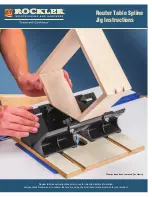
2480 & 2481 series Hydraulic Installation Tools (HK970)
18
Troubleshooting
1. Tool fails to operate when trigger is depressed:
a. Inoperative Powerig® Hydraulic Unit - see
applicable instruction manual
b. Loose air or electric connections
c. Damaged trigger assembly
d. Loose or faulty hydraulic hose coupling
e. Unloading valve not installed in tool
2. Tool operates in reverse:
a. Reversed hydraulic hose connections between
Powerig and tool
3. Tool leaks hydraulic fluid:
a. Defective Tool O-rings or loose hose connections at
tool
4. Hydraulic couplers leak fluid:
a. Damaged or worn O-rings in coupler body — see
Coupler, 110440
5. Hydraulic fluid overheats:
a. Hydraulic unit not operating properly — see manual
b. Unloading valve installed incorrectly
c. Powerig Hydraulic Unit running in reverse (918; 918-
5 only) — see Powerig instruction manual
6. Tool operates erratically; fastener not installed
properly:
a. Low or erratic hydraulic pressure — air in system
b. Damaged or worn piston O-ring in tool
c. Unloading valve installed incorrectly
d. Excessive wear on sliding surfaces of tool parts
e. Excessive wear of unloading valve in tool
7. Grooves on fastener pintail stripped during PULL
stroke:
a. Operator not sliding anvil completely onto fastener
pintail
b. Incorrect fastener grip
c. Worn or damaged jaw segments
d. Metal particles in pull grooves of jaw segments
e. Excessive sheet gap
8. Collar of HUCKBOLT® fastener not completely
swaged:
a. Improper tool operation — see Trouble 6
b. Scored anvil
9. Shear collar on Huck blind fastener not driven:
a. Improper tool operation
b. Worn or damaged driving anvil in nose assembly
10. Tool ”hangs-up” on swaged collar of HUCKBOLT
fastener:
a. Improper Tool operation — see Trouble 6
b. RETURN pressure too low
c. Nose assembly not installed correctly
11. Pintail of fastener fails to break:
a. Improper Tool operation — see Trouble 6
b. Pull grooves on fastener stripped — see Trouble 7
c. PULL pressure too low
d. Worn unloading valve
Always check the simplest possible cause of a malfunction first. For example, a loose or disconnected trigger
line. Then proceed logically, eliminating each possible cause until the defective part is located. Where possi-
ble, substitute known good parts for suspected defective parts. Use Trouble Shooting Chart as an aid for lo-
cating and correcting trouble.



































